迷宫可视化
实验任务(实验题目、目的)
Use VC++/Python to solve the Maze problem.
利用VC++/Python语言实现迷宫路径求解,要求图形界面,可用递归或非递归方式。
任务分析
实现思路
1. 将迷宫单元用二维列表表示,-1为墙,0为可以走的路
2. 首先初始化格子,等待输入,当点击按下后接受输入的迷宫列数,行数
3. 生成迷宫矩阵,据此画出迷宫。
4. 点击走迷宫按钮后,根据全局变量矩阵maz由三种算法计算路径。
涉及的知识点
迷宫生成算法:dfs算法,bfs算法,Prim算法,Kruskal算法
走迷宫算法:dfs算法,bfs算法,A*算法,(迪杰斯特拉算法,弗洛伊德算法)
PyQt5的布局与作图
bfs如何走迷宫并打印出迷宫路径(与dfs记录路径不一样)
出现的问题
关于Python参数传递问题(值传递 or 址传递)
如何动态刷新
关于pyqt5函数的一些参数问 题
使用的库
# -*- coding: utf-8 -*-
from PyQt5 import QtCore, QtGui, QtWidgets
import sys,random
from PyQt5.QtWidgets import QApplication,QMainWindow,QGraphicsItem
from PyQt5.QtCore import Qt,QRectF
import numpy as np
from queue import Queue,PriorityQueue
全局变量
WIDTH,HEIGHT=800,800 #Graphicsview的尺寸
COL_INTERVAL,ROW_INTERVAL = 3,3 #格子间的间距
COL_LEN,ROW_LEN = 20,20 #格子的长度
COL_NUM,ROW_NUM = 35,35 #格子的数量
FIND,GENERATE,SPEED=0,0,0 #生成方式,走迷宫方式,刷新速度
maz=np.ones((ROW_NUM,COL_NUM)) #迷宫矩阵
dx,dy=ROW_NUM - 2,COL_NUM - 1 #终点
record,ans,process= [],[],[] #记录答案
核心代码
深度优先生成迷宫
class DFSg ( object ):
def __init__ ( self , width= 11 , height= 11 ):
# 迷宫最小长宽为 5
assert width >= 5 and height >= 5 , "Length of width or height must be larger than 5."
# 确保迷宫的长和宽均为奇数
self .width = (width // 2 ) * 2 + 1
self .height = (height // 2 ) * 2 + 1
self .start = [ 1 , 0 ]
self .destination = [ self .height - 2 , self .width - 1 ]
self .matrix = None
def generate_matrix_dfs ( self ):
# 地图初始化,并将出口和入口处的值设置为 0
self .matrix = -np.ones(( self .height, self .width))
self .matrix[ self .start[ 0 ], self .start[ 1 ]] = 0
self .matrix[ self .destination[ 0 ], self .destination[ 1 ]] = 0
visit_flag = [[ 0 for i in range ( self .width)] for j in range ( self .height)]
def check ( row , col , row_, col_):
temp_sum = 0
for d in [[ 0 , 1 ], [ 0 , - 1 ], [ 1 , 0 ], [- 1 , 0 ]]:
temp_sum += self.matrix[row_ + d[ 0 ]][col_ + d[ 1 ]]
return temp_sum <= - 3
def dfs (row, col):
visit_flag[row][col] = 1
self.matrix[row][col] = 0
if row == self.start[ 0 ] and col == self.start[ 1 ] + 1 :
return
directions = [[ 0 , 2 ], [ 0 , - 2 ], [ 2 , 0 ], [- 2 , 0 ]]
random.shuffle(directions)
for d in directions:
row_, col_ = row + d[ 0 ], col + d[ 1 ]
if row_ > 0 and row_ < self.height - 1 and col_ > 0 and col_ < self.width - 1 and visit_flag[row_][
col_] == 0 and check(row, col, row_, col_):
if row == row_:
visit_flag[row][ min (col, col_) + 1 ] = 1
self.matrix[row][ min (col, col_) + 1 ] = 0
else :
visit_flag[ min (row, row_) + 1 ][col] = 1
self.matrix[ min (row, row_) + 1 ][col] = 0
dfs(row_, col_)
dfs( self .destination[ 0 ], self .destination[ 1 ] - 1 )
self .matrix[ self .start[ 0 ], self .start[ 1 ] + 1 ] = 0
P rim 算法生成迷宫
class PRIMg ( object ):
def __init__ ( self , width= 11 , height= 11 ):
assert width >= 5 and height >= 5 , "Length of width or height must be larger than 5."
self .width = (width // 2 ) * 2 + 1
self .height = (height // 2 ) * 2 + 1
self .start = [ 1 , 0 ]
self .destination = [ self .height - 2 , self .width - 1 ]
self .matrix = None
# 虽然说是 prim 算法,但是我感觉更像随机广度优先算法
def generate_matrix_prim ( self ):
# 地图初始化,并将出口和入口处的值设置为 0
self .matrix = -np.ones(( self .height, self .width))
def check (row, col):
temp_sum = 0
for d in [[ 0 , 1 ], [ 0 , - 1 ], [ 1 , 0 ], [- 1 , 0 ]]:
temp_sum += self.matrix[row + d[ 0 ]][col + d[ 1 ]]
return temp_sum < - 3
queue = []
row, col=(np.random.randint( 1 , self .height - 1 ) // 2 ) * 2 + 1 , (
np.random.randint( 1 , self .width - 1 ) // 2 ) * 2 + 1
queue.append((row, col, - 1 , - 1 ))
while len (queue) != 0 :
row, col, r_, c_ = queue.pop(np.random.randint( 0 , len (queue)))
if check(row, col):
self .matrix[row, col] = 0
if r_ != - 1 and row == r_:
self .matrix[row][ min (col, c_) + 1 ] = 0
elif r_ != - 1 and col == c_:
self .matrix[ min (row, r_) + 1 ][col] = 0
for d in [[ 0 , 2 ], [ 0 , - 2 ], [ 2 , 0 ], [- 2 , 0 ]]:
row_, col_ = row + d[ 0 ], col + d[ 1 ]
if row_ > 0 and row_ < self .height - 1 and col_ > 0 and col_ < self .width - 1 and self .matrix[row_][
col_] == - 1 :
queue.append((row_, col_, row, col))
self .matrix[ self .start[ 0 ], self .start[ 1 ]] = 0
self .matrix[ self .destination[ 0 ], self .destination[ 1 ]] = 0
K ruskal 算法生成迷宫
class KRUSKALg ( object ):
def __init__ ( self , width = 11 , height = 11 ):
assert width >= 5 and height >= 5 , "Length of width or height must be larger than 5."
self .width = (width // 2 ) * 2 + 1
self .height = (height // 2 ) * 2 + 1
self .start = [ 1 , 0 ]
self .destination = [ self .height - 2 , self .width - 1 ]
self .matrix = None
# 最小生成树算法 -kruskal (选边法)思想生成迷宫地图,这种实现方法最复杂。
def generate_matrix_kruskal ( self ):
# 地图初始化,并将出口和入口处的值设置为 0
self .matrix = -np.ones(( self .height, self .width))
def check (row, col):
ans, counter = [], 0
for d in [[ 0 , 1 ], [ 0 , - 1 ], [ 1 , 0 ], [- 1 , 0 ]]:
row_, col_ = row + d[ 0 ], col + d[ 1 ]
if row_ > 0 and row_ < self.height - 1 and col_ > 0 and col_ < self.width - 1 and self.matrix[row_, col_] == - 1 :
ans.append([d[ 0 ] * 2 , d[ 1 ] * 2 ])
counter += 1
if counter <= 1 :
return []
return ans
nodes = set ()
row = 1
while row < self .height:
col = 1
while col < self .width:
self .matrix[row, col] = 0
nodes.add((row, col))
col += 2
row += 2
unionset = UnionSet(nodes)
while unionset.count > 1 :
row, col = nodes.pop()
directions = check(row, col)
if len (directions):
random.shuffle(directions)
for d in directions:
row_, col_ = row + d[ 0 ], col + d[ 1 ]
if unionset.find((row, col)) == unionset.find((row_, col_)):
continue
nodes.add((row, col))
unionset.count -= 1
unionset.union((row, col), (row_, col_))
if row == row_:
self .matrix[row][ min (col, col_) + 1 ] = 0
else :
self .matrix[ min (row, row_) + 1 ][col] = 0
break
self .matrix[ self .start[ 0 ], self .start[ 1 ]] = 0
self .matrix[ self .destination[ 0 ], self .destination[ 1 ]] = 0
DFS算法走迷宫
def dfs (x,y):
global dx, dy,record,w
# Save(record)
# pp = processPaint()
# pp.setPos(0, 0)
# w.update(pp)
if x == dx and y == dy:
Keep(record)
return
for (kx, ky) in [[ 1 , 0 ], [- 1 , 0 ], [ 0 , 1 ], [ 0 , - 1 ]]:
if (check(kx + x, ky + y)):
record.append((kx + x, ky + y))
dfs(kx + x, ky + y)
record.pop()
BFS算法走迷宫
def bfs (t):
global que,dx,dy,record
lis={}
visited=[( 1 , 0 )]
que=Queue()
que.put(t)
while que:
temp=que.get()
if temp[ 0 ]==dx and temp[ 1 ]==dy:
break
for (kx, ky) in [[ 1 , 0 ], [- 1 , 0 ], [ 0 , 1 ], [ 0 , - 1 ]]:
x=kx + temp[ 0 ]
y=ky + temp[ 1 ]
if (x > 0 and y > 0 and x < ROW_NUM and y < COL_NUM and maz[x][y] == 0 and (x,y) not in visited):
que.put((x, y))
visited.append((x, y))
lis[(x,y)]=(temp[ 0 ],temp[ 1 ])
if (x==dx and y==dy):
break
record.append((dx,dy))
(x,y)=lis[(dx,dy)]
record.append((x, y))
while (x,y)!=( 1 , 0 ):
(x,y)=lis[x,y]
record.append((x, y))
Keep(record)
A*算法走迷宫
def Astar ():
start = ( 1 , 0 )
final = (ROW_NUM - 2 , COL_NUM - 1 )
front = PriorityQueue()
front.put(start)
father = {}
father[start] = None
sum_cost = {}
sum_cost[start] = 0
while front:
current = front.get()
if current == final:
break
for (dx, dy) in [[ 1 , 0 ], [- 1 , 0 ], [ 0 , 1 ], [ 0 , - 1 ]]:
x = current[ 0 ] + dx
y = current[ 1 ] + dy
if isOK((x, y)):
cost = sum_cost[current] + calcuCost(current, (x, y))
if (x, y) not in sum_cost or cost < sum_cost[(x, y)]:
sum_cost[(x, y)] = cost
priority = cost + heuristic(start, (x, y))
front.put((x, y), priority)
father[(x, y)] = current
if (x, y) == final:
break
temp=final
while temp:
record.append(temp)
temp=father[temp]
Keep(record)
实验结果
迷宫初始化
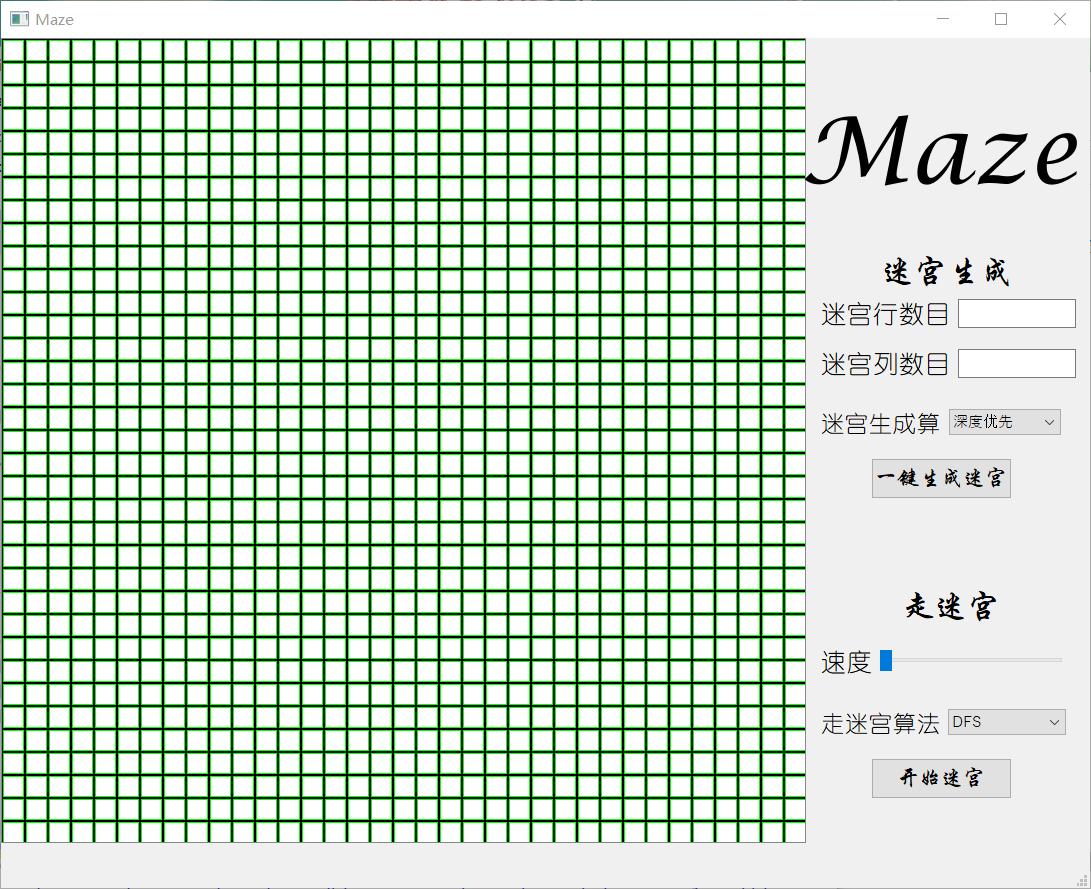
深度优先生成迷宫
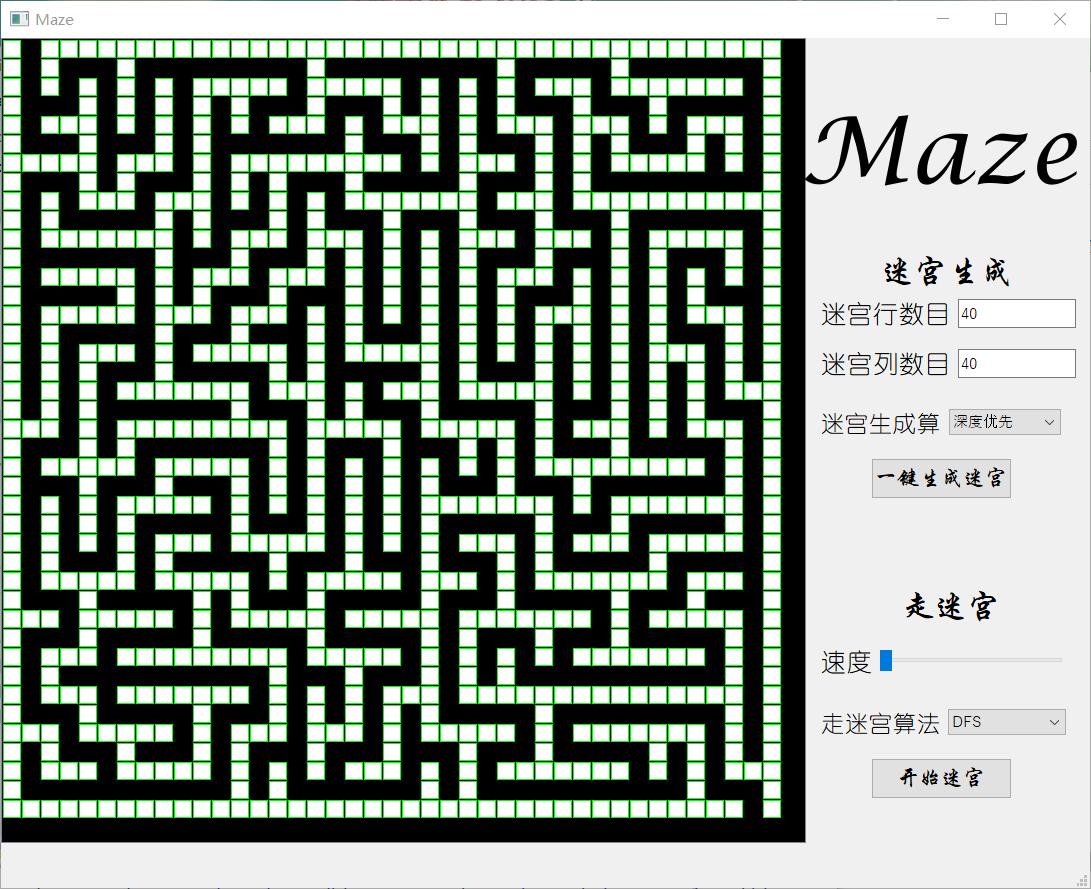
P rim 算法生成迷宫

K ruskal 算法生成迷宫
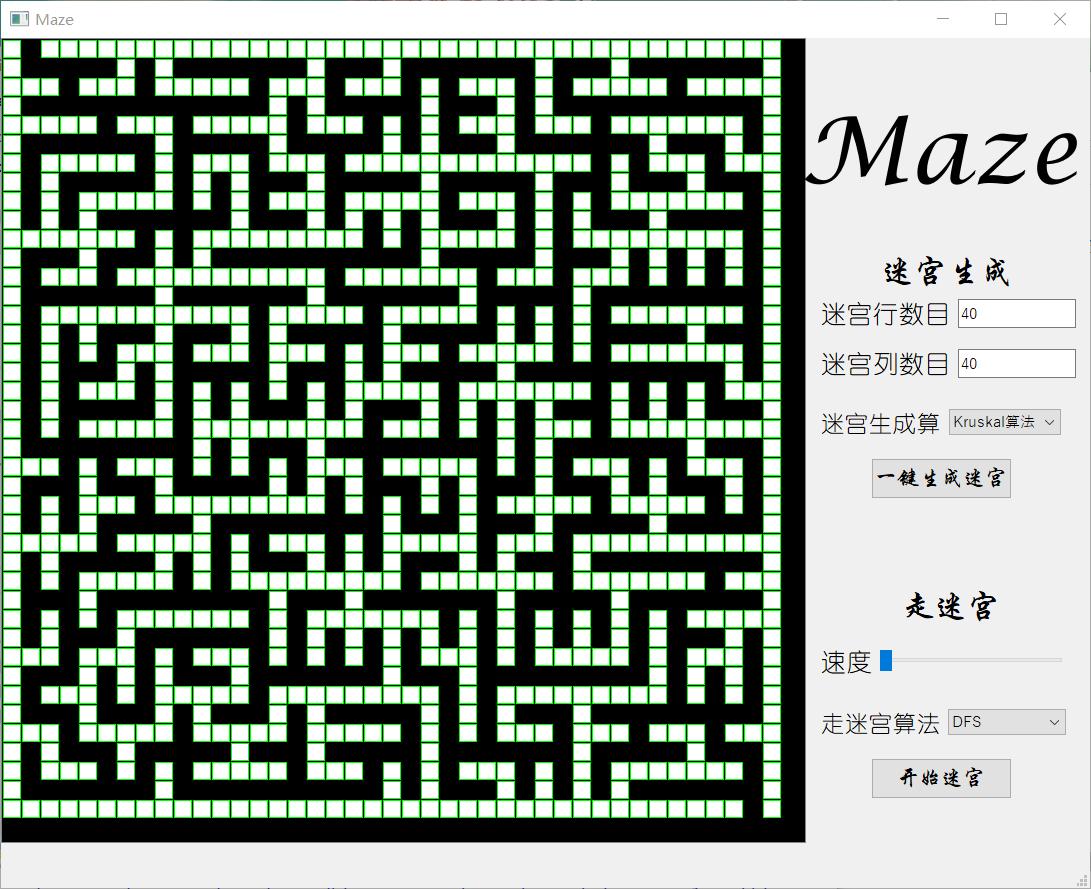
DFS走迷宫
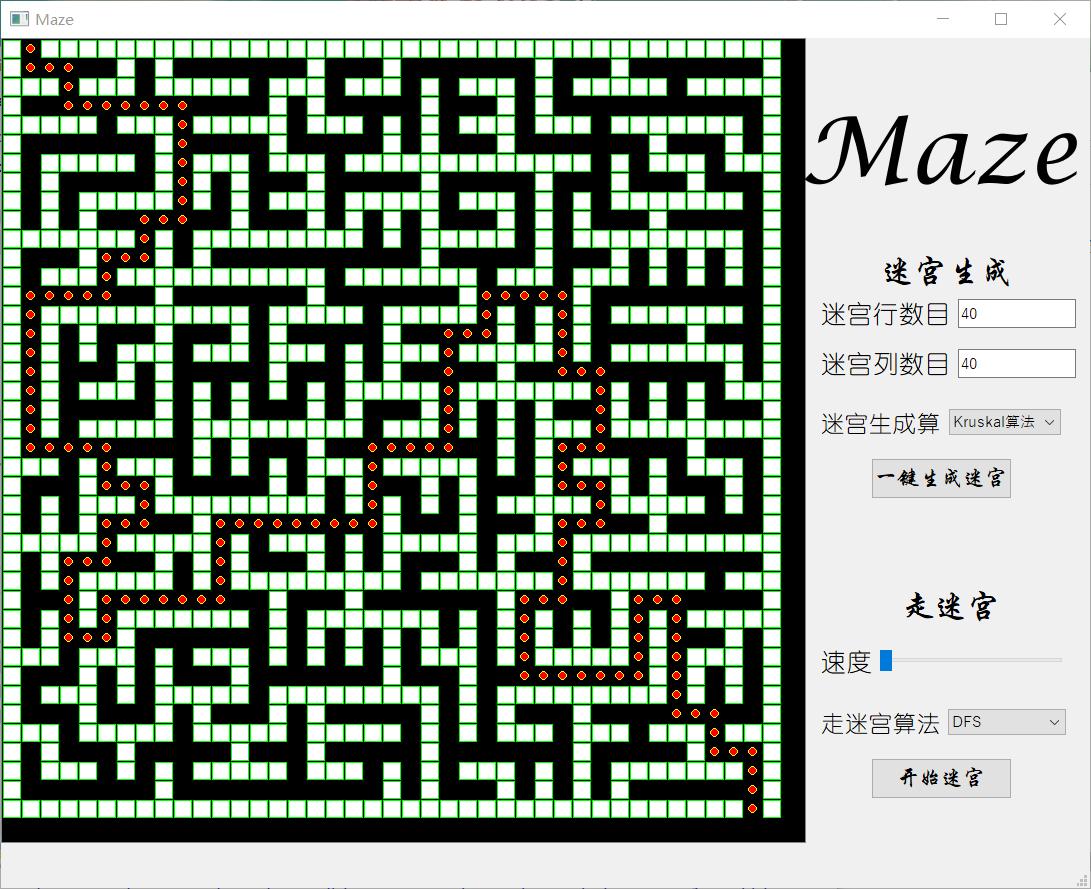
BFS走迷宫
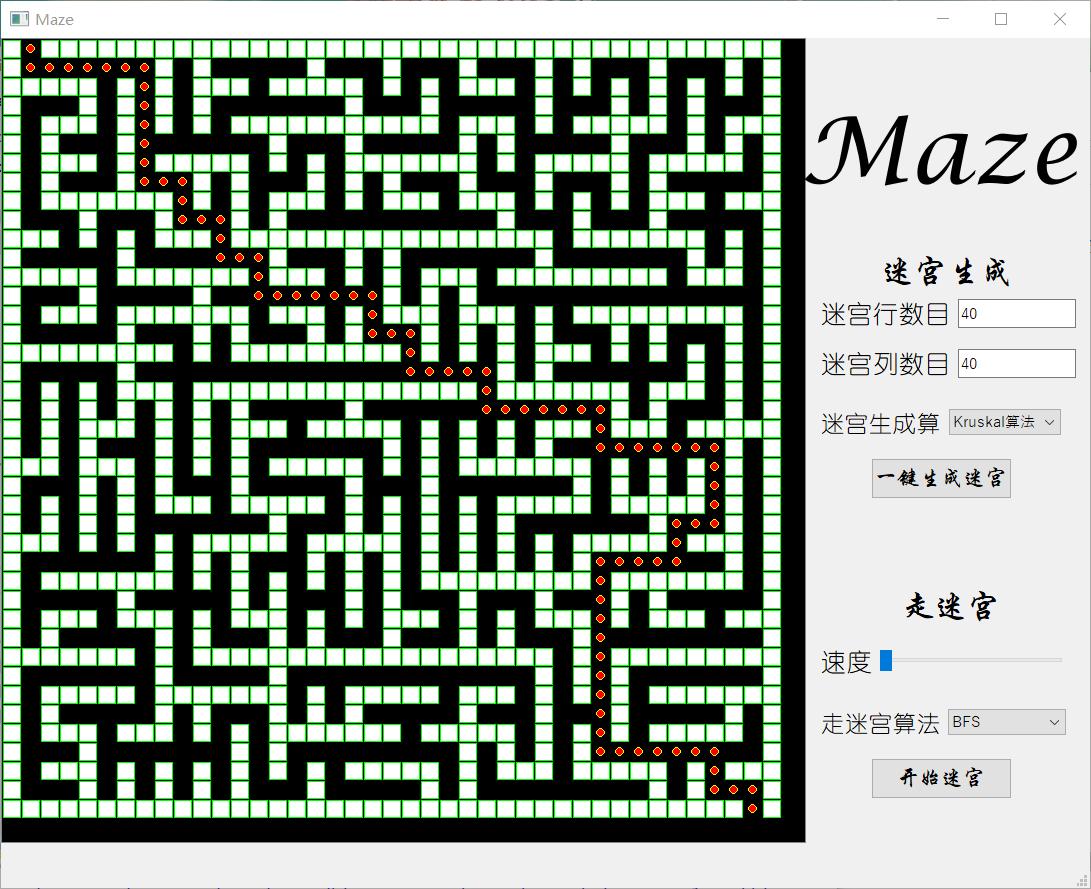
A * 算法走迷宫
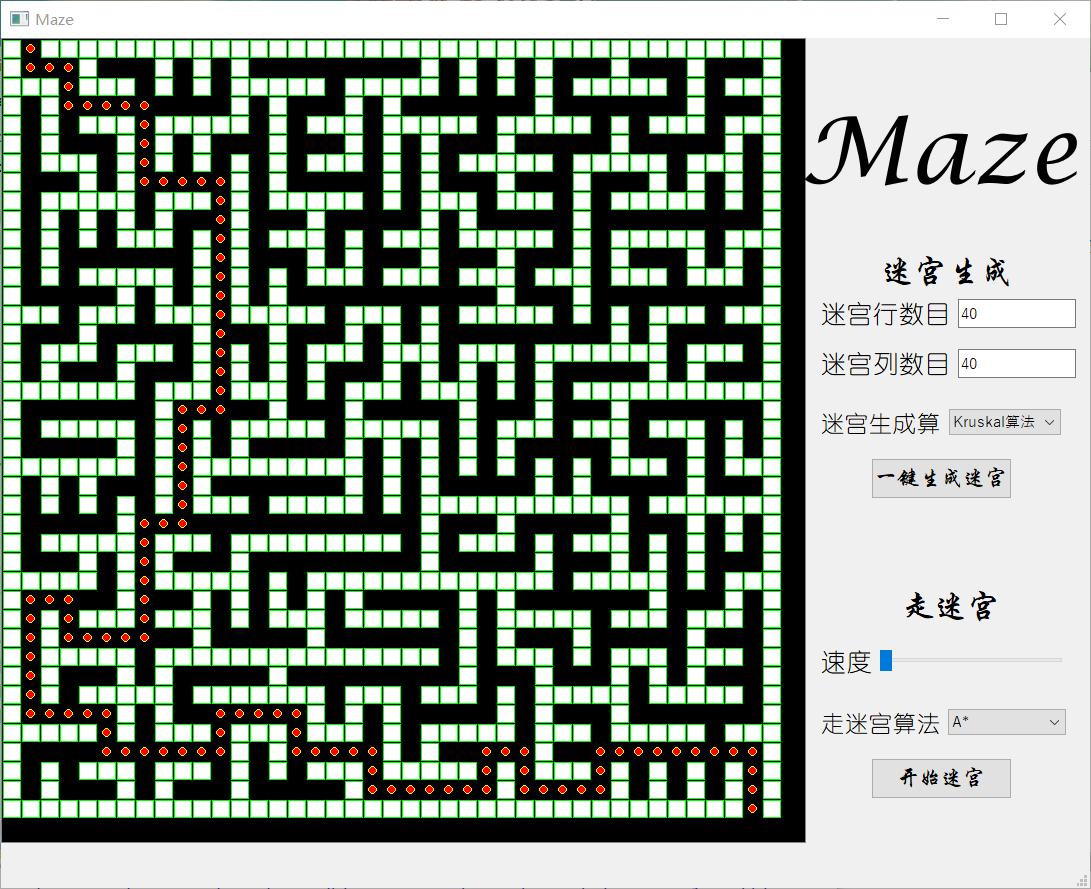
评阅
本文章由word文档转换而成